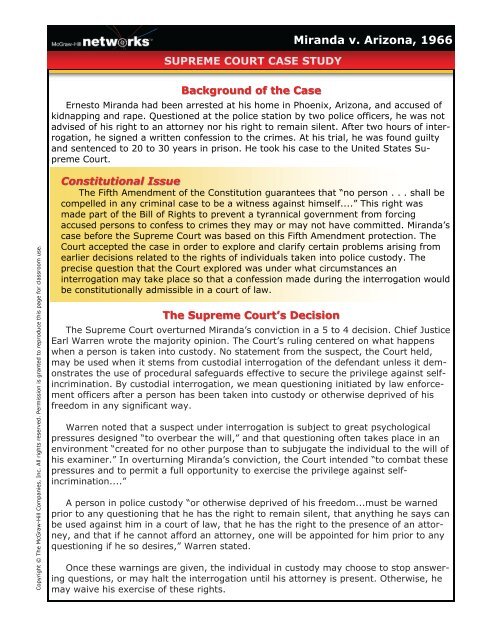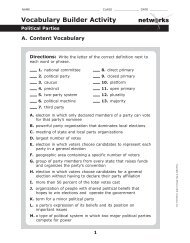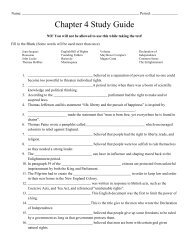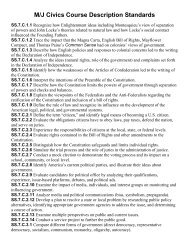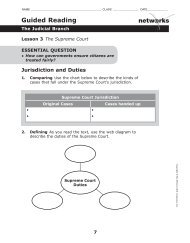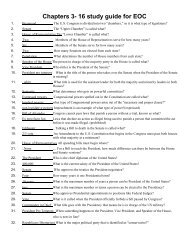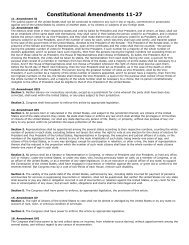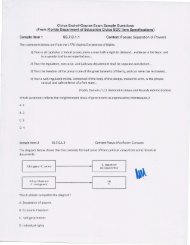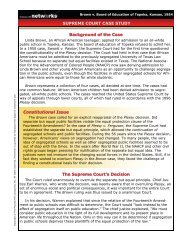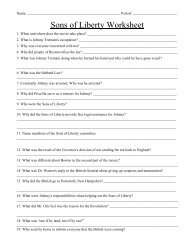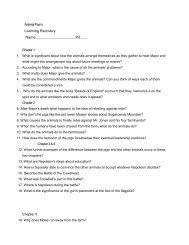Miranda v. Arizona, 1966
Miranda v. Arizona, 1966
Miranda v. Arizona, 1966
Create successful ePaper yourself
Turn your PDF publications into a flip-book with our unique Google optimized e-Paper software.
SUPREME COURT CASE STUDY<br />
<strong>Miranda</strong> v. <strong>Arizona</strong>, <strong>1966</strong><br />
Background of the Case<br />
Ernesto <strong>Miranda</strong> had been arrested at his home in Phoenix, <strong>Arizona</strong>, and accused of<br />
kidnapping and rape. Questioned at the police station by two police officers, he was not<br />
advised of his right to an attorney nor his right to remain silent. After two hours of interrogation,<br />
he signed a written confession to the crimes. At his trial, he was found guilty<br />
and sentenced to 20 to 30 years in prison. He took his case to the United States Supreme<br />
Court.<br />
Copyright © The McGraw-Hill Companies, Inc. All rights reserved. Permission is granted to reproduce this page for classroom use.<br />
Constitutional Issue<br />
Constitutional Issue<br />
The Fifth Amendment of the Constitution guarantees that “no person . . . shall be<br />
compelled in any criminal case to be a witness against himself....” This right was<br />
made part of the Bill of Rights to prevent a tyrannical government from forcing<br />
accused persons to confess to crimes they may or may not have committed. <strong>Miranda</strong>’s<br />
case before the Supreme Court was based on this Fifth Amendment protection. The<br />
Court accepted the case in order to explore and clarify certain problems arising from<br />
earlier decisions related to the rights of individuals taken into police custody. The<br />
precise question that the Court explored was under what circumstances an<br />
interrogation may take place so that a confession made during the interrogation would<br />
be constitutionally admissible in a court of law.<br />
The Supreme Court’s Decision<br />
The Supreme Court overturned <strong>Miranda</strong>’s conviction in a 5 to 4 decision. Chief Justice<br />
Earl Warren wrote the majority opinion. The Court’s ruling centered on what happens<br />
when a person is taken into custody. No statement from the suspect, the Court held,<br />
may be used when it stems from custodial interrogation of the defendant unless it demonstrates<br />
the use of procedural safeguards effective to secure the privilege against selfincrimination.<br />
By custodial interrogation, we mean questioning initiated by law enforcement<br />
officers after a person has been taken into custody or otherwise deprived of his<br />
freedom in any significant way.<br />
Warren noted that a suspect under interrogation is subject to great psychological<br />
pressures designed “to overbear the will,” and that questioning often takes place in an<br />
environment “created for no other purpose than to subjugate the individual to the will of<br />
his examiner.” In overturning <strong>Miranda</strong>’s conviction, the Court intended “to combat these<br />
pressures and to permit a full opportunity to exercise the privilege against selfincrimination....”<br />
A person in police custody “or otherwise deprived of his freedom...must be warned<br />
prior to any questioning that he has the right to remain silent, that anything he says can<br />
be used against him in a court of law, that he has the right to the presence of an attorney,<br />
and that if he cannot afford an attorney, one will be appointed for him prior to any<br />
questioning if he so desires,” Warren stated.<br />
Once these warnings are given, the individual in custody may choose to stop answering<br />
questions, or may halt the interrogation until his attorney is present. Otherwise, he<br />
may waive his exercise of these rights.
<strong>Miranda</strong> v. <strong>Arizona</strong>, <strong>1966</strong><br />
SUPREME COURT CASE STUDY continued<br />
In such a case, there would be “a heavy burden ...on the Government to demonstrate<br />
that the defendant knowingly and intelligently waived his privilege against selfincrimination<br />
and his right to ...counsel.”<br />
The <strong>Miranda</strong> ruling applies only to interrogations. The Court emphasized that such<br />
safeguards were “not intended to hamper the traditional function of police officers in investigating<br />
crime....” The ruling was not meant to bar “general on-the-scene questioning<br />
as to facts surrounding a crime or other general questioning of citizens in the factfinding<br />
process....” In addition, the Chief Justice declared, the Fifth Amendment does<br />
not bar voluntary statements from a person who, for example, enters a police station<br />
“...to confess to a crime, or a person who calls the police to offer a confession or any<br />
other statement he desires to make.”<br />
Copyright © The McGraw-Hill Companies, Inc. All rights reserved. Permission is granted to reproduce this page for classroom use.<br />
The <strong>Miranda</strong> ruling has led to the practice now followed routinely by arresting police<br />
officers and other law enforcement officials during which they read a suspect his or her<br />
<strong>Miranda</strong> rights.<br />
Dissenting Opinion<br />
Justices John Marshall Harlan, Tom C. Clark, Potter Stewart, and Byron White dissented.<br />
They saw no historical precedent for the majority position and feared the decision<br />
could weaken law enforcement. Justice White condemned the majority for creating<br />
law enforcement directives he viewed as inflexible, while at the same time leaving many<br />
unanswered questions.<br />
DIRECTIONS: Answer the following questions on a separate sheet of paper.<br />
1. How has the Supreme Court interpreted the Fifth Amendment’s protection against<br />
self-incrimination to apply to all persons questioned in connection with a crime<br />
2. Suppose you were arrested as a suspect in a crime. The arresting officers rush you to<br />
a tiny room where they question you for 12 hours without a stop. Then, too weary to<br />
protest, you sign a confession. How would the Court’s <strong>Miranda</strong> decision protect you in<br />
such a situation<br />
3. At the scene of a crime, a police officer questions witnesses about the details of a<br />
holdup. The officer suspects that some of the witnesses are connected with the<br />
crime. How does the <strong>Miranda</strong> decision apply in such an instance<br />
4. What do you think would happen if a person convicted of a crime proved that she or<br />
he was not informed of the <strong>Miranda</strong> rights when questioned by the police<br />
5. In recent years, the <strong>Miranda</strong> decision has been criticized by some persons as protecting<br />
the rights of criminals and neglecting the rights of crime victims. Do you agree or<br />
disagree with this point of view Why


